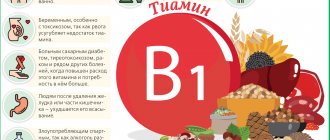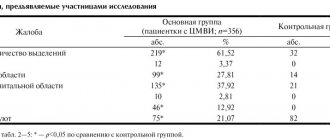Vitamin B. Hypervitaminosis
Symptoms
Taking into account the above features of the metabolism of B vitamins, one could assume a statistical predominance of one-time, acute overdoses caused by more or less random intake of concentrated drugs in large volumes.
However, if we add psychological (self-prescribed treatment and prevention) and iatrogenic (inadequate dosages of vitamin therapy prescribed by a doctor) to the biochemical nuances, a significant proportion of chronic hypervitaminosis B also becomes clear. The vast majority of such cases are overdoses of B1, B3, B5, B6, B9 and B12. The most typical and common symptoms are increased excitability, emotional instability, tachycardia, headaches, nausea, redness of the skin, dyssomnia (certain sleep disorders).
Vitamin B1 (thiamine) in excess doses can cause anaphylactic shock, skin reactions such as urticaria and increased photosensitivity, kidney and liver dysfunction.
Vitamin B3 (niacin, vitamin PP, nicotinic acid) in overdose causes, in addition to the above-mentioned symptom complex, severe dyspepsia, dizziness, itching and paresthesia (false tactile sensations), muscle pain, cardiovascular disorders (high blood pressure in a standing position).
Acute hypervitaminosis B5 (pantothenic acid) can, among other things, cause dehydration.
Overdose of B6 (adermine, pyridoxine) – atactic phenomena in the form of impaired coordination of movements, confusion, convulsions, increased acidity of gastric secretions.
Hypervitaminosis B9 (folic acid) – cramps in the lower extremities, allergic reactions. In addition, in 2016 , the results of a study conducted by employees of the Johns Hopkins Institute (USA) on medical and statistical data for the period 1998-2013 were published. It has been shown that unreasonable and deliberately excessive consumption of folic acid and cobalt-containing vitamins B12 by pregnant women (and the importance of these vitamins during gestation is well known) increases the risk of autism in children by 2-3 times, especially if “hyperprophylaxis” occurred in the third trimester. In addition, B12 increases blood clotting and, accordingly, the risk of blood clots. In general, the results of the study make us think seriously and once again raise the question of the feasibility, the need for the most careful monitoring, taking into account all indications and contraindications for vitamin therapy and vitamin prophylaxis during pregnancy: in many cases, the optimal level of con in the blood was exceeded by 15-17 or more times . The most severe complications of hypervitaminosis B include renal and liver failure, steatohepatosis, pulmonary edema, anaphylactic shock, exacerbation of gastroenterological and cardiac diseases.
It is interesting to note that the clinical picture of hypervitaminosis B is largely reminiscent or even repeats the symptoms of hypovitaminosis.
B vitamins in clinical practice
THOSE.
Morozova , Doctor of Medical Sciences, Professor,
O.S.
Durnetsova , Candidate of Medical Sciences,
First Moscow State Medical University named after.
THEM. Sechenov The article discusses the role of B vitamins in the treatment of neurological diseases. The results of research and experience in using the combined drug Neuromultivit are covered.
Vitamins play an important role in the normal functioning of the body, as well as in the pathogenesis of certain diseases, many of which are indispensable participants in various metabolic processes. They are necessary for normal cellular metabolism and tissue trophism, normal performance and maintenance of vital functions of the body. A variety of reasons lead to vitamin deficiency, such as diseases of the gastrointestinal tract leading to malabsorption, malnutrition, alcoholism, metabolic disorders, etc. Currently, more than 30 vitamins and vitamin-like substances are known. Most of them are coenzymes of various enzymes and are involved in the regulation of carbohydrate, protein, fat and mineral metabolism, in maintaining cellular structure, and the body’s resistance to adverse environmental factors [1].
Vitamins are divided into fat-soluble (vitamins A, D, E and K) and water-soluble (B vitamins and vitamin C). The absence of any of them leads to insufficient formation of certain vital enzymes in the body and, as a consequence, to a specific metabolic disorder. Thus, it is well known that retinol (vitamin A) plays an important role in the processes of growth, reproduction, and visual function; vitamin K is necessary for the synthesis of coagulation factors II, VII, IX and X in the liver and has antihemorrhagic properties; vitamin D regulates the mineralization of bone tissue, increases the permeability of the intestinal epithelium to calcium and phosphates, B vitamins are neurotropic and are used for diseases of the nervous system, etc. [2].
Clinical symptoms and manifestations of hypovitaminosis are diverse and can affect various organs and systems ( Table 1
). Since most vitamins are not synthesized in the body, and it is impossible to compensate for their deficiency using only food, vitamin medications are of great importance. They are widely used for prevention and as part of complex therapy for diseases of various human organs and systems [1]. Currently, vitamin complexes are increasingly used to correct functional states and increase human reserve capabilities in various clinical situations [3].
Table 1. Clinical manifestations and symptoms of hypovitaminosis
| Vitamin deficiency | Clinical manifestations and symptoms |
| A (retinol) |
|
| B1 (thiamine) |
|
| B2 (riboflavin) |
|
| B6 (pyridoxine) |
|
| B12 (cyanocobalamin) |
|
| C (ascorbic acid) |
|
| E (tocopherol) |
|
| D |
|
| K |
|
| Lack of vitamin PP (nicotinic acid) |
|
In this review, we will dwell in more detail on the pharmacological aspects and clinical possibilities of using B vitamins.
B vitamins
B vitamins occupy an important place in clinical practice.
They are used in a variety of fields of medicine in various categories of patients, but they are most widely used in the treatment of diseases of the peripheral and central nervous system. B vitamins are considered neurotropic, because they are necessary for the normal functioning of the central and peripheral nervous system. B vitamins have a metabolic effect on axonal transport and myelination processes in peripheral nerve fibers. Among all the B vitamins, these properties are most characteristic of three of them - thiamine (B1), pyridoxine (B6) and cyanocobalamin (B12). The effect of B vitamins, primarily thiamine, on the central nervous system is mediated through the metabolism of gamma-aminobutyric acid (GABA) and serotonin, which also provides an analgesic effect that manifests itself when used in high doses. The main physiological effects are summarized in Table 2
[4—6].
Table 2. Physiological effects of B vitamins
| Vitamin B1 (thiamine) | Vitamin B6 (pyridoxine) | Vitamin B12 (cyanocobalamin) |
| It is a coenzyme of many reactions. Participates in: - dihydrogenase complexes of the Krebs cycle - regulation of the activity of the pentose phosphate cycle of carbohydrate utilization - conduction of nerve impulses - ensuring axonal transport that determines the regeneration of nervous tissue - modulation of neuromuscular transmission in H-cholinergic receptors (synthesis of norepinephrine) - regulation of pain » nerve activity | It is a cofactor of more than 100 enzymes. Participates in: - deamination, transamination, decarboxylation of amino acids - phosphorylation of glycogen - folic acid metabolism - biosynthesis of neurotransmitters (dopamine, norepinephrine, adrenaline, histamine) - ensuring inhibition processes in the central nervous system - CNS (synthesis of gamma-aminobutyric acid ) - regulation of energy processes in nervous tissue Promotes the accumulation of magnesium in cells | Activates folic acid Participates in: - hematopoiesis and erythropoiesis (prevention of neuroanemic syndrome) - stimulation of nucleic acid metabolism - synthesis/restoration of the myelin sheath - cell growth replication processes - activation of the blood coagulation system - regulation of gastrointestinal tract function Has an analgesic effect Reduces neurogenic pain (reduces glutamate synthesis in the central nervous system) |
It should be emphasized that vitamin B1 (thiamine) is necessary for the oxidative decarboxylation of keto acids (pyruvic and lactic), the synthesis of acetylcholine, it is involved in carbohydrate metabolism and related energy, fat, protein, water-salt metabolism, has a regulatory effect on trophism and activity of the nervous system. With insufficient intake of thiamine, pyruvic and lactic acids accumulate in tissues, the synthesis of acetylcholine is disrupted, as a result of which the functions of a number of systems, primarily the nervous, cardiovascular and digestive ones, deteriorate. Thiamine optimizes cognitive activity and brain function. It has a positive effect on energy levels, growth, normal appetite, learning ability and is essential for muscle tone in the digestive tract, stomach and heart. Thiamine acts as an antioxidant, protecting the body from the destructive effects of aging, alcohol and tobacco.
Vitamin B6 (pyridoxine) is involved in the synthesis of a number of neurotransmitters. In phosphorylated form, it provides the processes of decarboxylation, transamination, deamination of amino acids, participates in the synthesis of protein, enzymes, hemoglobin, prostaglandins, the metabolism of serotonin, catecholamines, glutamic acid, GABA, histamine, improves the use of unsaturated fatty acids, reduces cholesterol and lipids in the blood, improves myocardial contractility, promotes the conversion of folic acid into its active form, stimulates hematopoiesis.
The most important property of vitamin B12 (cyanocobalamin) is its participation in hematopoiesis and erythropoiesis (prevention of neuroanemic syndrome) and activation of the blood coagulation system. In addition, like two other B vitamins, it is involved in the synthesis/regeneration of the myelin sheath and has an analgesic effect in neurogenic pain syndrome (reduces the synthesis of glutamate in the central nervous system).
Each of these vitamins can be used as monotherapy, but a combination of B vitamins (B1, B6, B12) has a more pronounced effect, since B vitamins can complement each other’s effects in the biochemical processes of nervous tissue [7, 8].
A wide area of application of drugs containing B vitamins is various pain syndromes. There is extensive experience in using them in cases of both nocioceptive and mixed pain of medium and low intensity, in the treatment of neuropathic pain, as a preventive treatment after relieving exacerbation of chronic pain, and in polyneuropathies of various origins. High doses of B vitamins have a positive effect on nerve regeneration, which justifies their use in the relief of acute pain syndrome and for the prevention of exacerbations of chronic pain [7, 9].
The optimal route of administration of B vitamins is oral. The use of parenteral forms may be complicated by the development of infiltrates and inflammatory reactions at the site of drug administration.
One of the drugs for oral administration containing a combination of the 3 B vitamins listed above in high doses is Neuromultivit (Lannacher, Austria), which is widely used in the practice of neurologists and endocrinologists. It contains 3 B vitamins in therapeutic doses (100 mg of thiamine hydrochloride, 200 mg of pyridoxine hydrochloride and 200 mcg of cyanocobalamin (vitamin B12). The absence of unwanted interactions between the components determines the generally good bioavailability of the drug. The components of the drug Neuromultivit are water-soluble vitamins, which eliminates the possibility of their cumulation in the body. Thiamine and pyridoxine are absorbed in the upper intestine, the degree of absorption depends on their dose. The absorption of cyanocobalamin is largely determined by the presence of an internal factor in the stomach and upper intestine, and further delivery of cyanocobalamin to the tissues is carried out by the transport protein transcobalamin II . Thiamine, pyridoxine and cyanocobalamin are metabolized in the liver. Thiamine and pyridoxine are excreted by the kidneys (about 8-10% unchanged). In case of overdose, the excretion of thiamine and pyridoxine through the intestines significantly increases. Cyanocobalamin is excreted mainly in bile, the degree of excretion by the kidneys is variable - from 6 to 30% [1, 3].
The use of B vitamins in neurological practice
As already noted, B vitamins are neurotropic substances.
Due to their active participation in biochemical processes that ensure the normal functioning of the structures of the nervous system, they are used in diabetic polyneuropathy and in the treatment of pain syndromes. Combined preparations of B vitamins are also used for complex therapy of pain syndromes [10]. In the practice of a doctor in almost any specialty, patients with dorsalgia or, in other words, with pain syndrome (PS) in the back area, are quite often encountered, the proportion of which is growing. The incidence of BS is quite high. Epidemiological studies have shown that on average 60-70% of the population have experienced acute back pain at least once in their lives, and in a third, the nature of the pain changes and becomes chronic. Often, pain syndrome occurs at a young age and subsequently accompanies the patient throughout his life. Moreover, among pain neurological syndromes of nociceptive origin caused by damage to the muscular system, myofascial pain has taken one of the first places in recent years [11].
The quality of life of these patients largely depends on timely, correctly selected and adequate pharmacotherapy. Inadequate treatment often leads to chronic pain syndrome. It is no secret that a large number of patients self-medicate, trying to reduce the severity of pain by taking painkillers and nonsteroidal anti-inflammatory drugs (NSAIDs).
Another possible cause of pain is various polyneuropathies. Among all types of neuropathies, diabetic polyneuropathy firmly ranks first, significantly ahead of other types of neuropathies (alcoholic, mixed origin, inflammatory, toxic, etc.), and the proportion of such patients is very large in general clinical practice [12].
The tactics of managing patients with pain syndrome involves the use of non-drug and drug treatment methods, the main goal of which is to relieve the pain syndrome or, at a minimum, reduce its severity. The therapy is also aimed at treating the underlying pathological process that led to the formation of the pain syndrome and improving the patient’s quality of life.
During the period of exacerbation, it is necessary to adhere to a gentle regime of physical activity and limit stress. Physiotherapy, manual therapy, acupuncture, and physical activity aimed at strengthening the muscle corset and stretching certain muscles or muscle groups are used. Non-drug recommendations also include recommendations for changing the patient’s habits, developing the “right” skills, teaching muscle relaxation techniques, correcting posture, teaching weight lifting techniques, and performing certain types of physical activity.
For pharmacotherapy of acute and chronic pain syndrome, it is possible to use various classes of drugs, which include B vitamins, both in monotherapy and in combination with each other ( Table 3
): - NSAIDs, - B vitamins, - muscle relaxants, - chondroprotectors, - antidepressants, - anticonvulsants, - selective serotonin reuptake inhibitors (SSRIs), - blockade with local anesthetics (in severe cases), - narcotic analgesics [11].
Table 3. Differentiated approach to pain therapy
| Nociceptive pain | Neuropathic pain |
| NSAIDs | |
| non-narcotic analgesics | |
| Narcotic analgesics (for severe pain) | |
| B vitamins | |
| Muscle relaxants | |
| chondroprotectors | |
| antidepressants | |
| anticonvulsants | |
| SSRIs | |
| Novocaine blockades | |
The pathogenetic basis for choosing a drug for the treatment of pain is based on knowledge, on the one hand, of the main pathophysiological mechanisms of its formation, and on the other, the mechanisms of action of the drug.
Since back pain is often mixed in nature with the participation of nociceptive and neuropathic components, it is advisable to prescribe both NSAIDs, which have a greater effect on the nociceptive component, and B vitamins, which affect the neuropathic component.
It is known that for various pain syndromes, B vitamins are often used to relieve it, which can have their own analgesic effect, and also enhance the analgesic effect of NSAIDs. Numerous studies have proven that under the influence of B vitamins, patients with acute back pain experience clinical improvement.
The analgesic effect of B vitamins has been known in medicine for a long time. As many years of clinical experience show, intramuscular administration of a combination of thiamine, pyridoxine and cyanocobalamin helps relieve pain, normalizes reflex reactions, and reduces sensitivity disorders. The mechanism of this action lies primarily in the inhibition of nociceptive responses. The antinociceptive effect of the combined vitamin complex may be due to inhibition of synthesis and/or blocking the action of inflammatory mediators. Clinically and in experimental models, it has been shown that co-administration with B vitamins enhances the analgesic effect of non-steroidal anti-inflammatory drugs, the anti-allodynic effect of gabapentin, dexamethasone and valproate in neuropathies [10].
Considering these properties of B vitamins, the main indications for the use of Neuromultivit are various diseases and lesions of the nervous system with pain syndromes:
- polyneuropathy; - neuritis; neuralgia; trigeminal neuralgia; - radicular syndrome caused by degenerative changes in the spine; sciatica; lumbago; - plexite; intercostal neuralgia; - paresis of the facial nerve.
Experience in using the combination drug Neuromultivit
The clinical effectiveness and good safety profile of the drug Neuromultivit for various diseases have a large evidence base, including meta-analyses [5, 13-16].
In recent years, there has been a fairly large number of works reflecting the experience of using the complex drug Neuromultivit in different categories of patients. These are mainly patients with neuropathies of various origins (diabetic, alcoholic) and pain syndromes in the back (dorsalgia). In patients with diabetes and endocrine neuropathy, positive dynamics with the use of Neuromultivit is expressed in the form of improved vibration and tactile sensitivity, reduced pain and increased quality of life in patients with DPN [14-16].
The results of a large number of studies of the drug Neuromultivit indicate a good safety profile and good tolerability of the drug by most patients. A Cochrane systematic review, including the results of 30 studies involving 741 patients with alcoholic and endocrine neuropathy, convincingly demonstrated that B vitamins were well tolerated in clinical studies [17–19].
In isolated cases, side effects may appear, most often associated with an overdose of the drug components, manifested by nausea, palpitations, and sometimes skin reactions develop in the form of itching and urticaria. Overdose is only possible if extremely high doses are taken for a very long time.
There are restrictions on the use of the drug during pregnancy and lactation.
Since Neuromultivit contains therapeutic doses of vitamins, it is not recommended to combine it with other B vitamins. Clinical symptoms of an overdose of vitamins contained in the Neuromultivit drug are possible only if the recommended doses are significantly exceeded, mainly due to vitamin B6 (if its dose is more than 2 g per day ). In this case, there is a risk of developing neuropathy with ataxia and sensory disturbances, seizures with EEG changes, in some cases hypochromic anemia and seborrheic dermatitis. Treatment is symptomatic.
Issues of contraindications to the prescription of certain drugs are important in the practice of any doctor. This fully applies to vitamin preparations. The practicing physician must have detailed information about who can and cannot be prescribed vitamin preparations. Very often this question concerns patients with tumor processes of both benign and malignant nature. Research results demonstrate weak anticarcinogenic activity or the absence of any effect on tumor growth of vitamins in physiological doses [20-24]. A number of studies have demonstrated the safety of taking vitamins, including B vitamins, in cancer patients [25-27]. Also, B vitamins can be part of complex maintenance therapy during or after chemotherapy [28].
Thus, the complex drug Neuromultivit can be recommended for use as part of complex therapy for pain syndromes of various origins, for manifestations of polyneuropathy of various origins (including alcoholic and diabetic polyneuropathy) and even in some cases as part of maintenance therapy for cancer patients. It is also widely used in neurological practice in the complex treatment of patients suffering from neuritis, neuralgia, sciatica, lumbago, as well as radicular syndrome, which is caused by degenerative changes in the spine, plexitis, intercostal neuralgia, facial paresis and trigeminal neuralgia.
Neuromultivit can be prescribed as part of complex therapy in combination with NSAIDs, muscle relaxants, and various non-drug therapies, enhancing their analgesic effect. The drug can also be used as maintenance therapy after discontinuation of NSAIDs to reduce the risk of relapse and chronic pain.
Literature
1. Clinical pharmacology: national guidelines. Ed. Yu.B. Belousova, V.K. Lepakhina, V.I. Petrova. M.: GEOTAR-Media, 2008. (Series “National Guides”, chapter 37). 2. Fauci AS, Braunwald E, Isselbacher KJ. Harrison's principles of internal medicine14th edition, 1998. Chapter 79: Vitamin deficiency and excess. P. 480-7. 3. Shikh E.V. Clinical and pharmacological aspects of the use of vitamin preparations in the clinic of internal diseases. Ministry of Health of the Russian Federation. Gazette of the Scientific Center for Expertise and State Control of Medicines. 2001, 1 (5): 46-52. 4. Leninger A.L. Fundamentals of biochemistry. Per. from English T. 1, 2, 3. M.: Mir, 1985. 5. Kozelkin A.A., Kuznetsov A.A., Medvedkova S.A. Application of neuromultivit in neurological practice. Therapia, 2008, 11(31): 1-5. 6. Akhmedzhanova L.T., Solokha O.A., Strokov I.A. B vitamins in the treatment of neurological diseases. RMJ, 2009, 17(11): 776-83. 7. Strokov I.A. The use of high doses of B vitamins in neurology. I.A. Strokov, L.T. Akhmedzhanova, O.A. Solokha. Difficult Patient, 2009, 10: 17-22. 8. Becker KW, Kienecker EW, Dick P. A contribution to the scientific assessment of degenerative and regenerative processes of peripheral nerves following axonotmesis under the systemic administration of vitamins B1, B6 and B12 – light and electron microscopy findings of the saphenous nerve in the rabbit. Neurochirurgia (Stuttg.), 1990, 33(4): 113-121. 9. Lutsky I.S., Lyutikova L.V., Lutsky E.I. B vitamins in neurological practice. Int. Neurol J., 2008, 2: 89-93. 10. Danilov A.B. The use of B vitamins for back pain: new analgesics? RMJ, 2008, 16: 35-9. 11. Vyalov S.S. Patients with lumbar neuralgia: features of treatment for lumbar syndrome. Polyclinic Physician's Handbook, 2013, 12: 16-22. 12. Doskina E.V. Diabetic polyneuropathy and B12 deficiency conditions: basics of pathogenesis, ways of treatment and prevention. E.V. Rumyantseva. Farmateka, 2011, 20: 1-6. 13. Zhirov I.V. Experience with the use of the drug Neuromultivit for alcoholic polyneuropathy. I.V. Zhirov, M.A. Fedina, A.B. Pokrovsky. New Drugs, 2002, 12: 10-18. 14. Gurevich K.G. Neuromultivitis: application in modern practice. Pharmatheka, 2004, 9-10: 48-51. 15. Tokmakova A.Yu. Possibilities of using Neuromultivit in complex therapy of polyneuropathy in patients with diabetes mellitus. A.Yu. Tokmakova, M.B. Antsiferov. Diabetes Mellitus, 2001, 11(2): 33-35. 16. Bregovsky V.B. Application of Neuromultivit in patients with chronic diabetic sensorimotor polyneuropathy of the lower extremities. V.B. Bregovsky, E.V. Belogurova, V.A. Kuzmina. New Drugs, 2002, 6: 7-10. 17. Ang CD, Alviar MJ, Dans AL et al. Vitamin B for treating peripheral neuropathy. Cochrane Database Syst Rev., 2008, 16(3). 18. Peters TJ, Kotowicz J, Nyka W et al. Treatment of alcoholic polyneuropathy with vitamin complex: a randomized controlled trial. Alcohol & Alcoholism, 2006, 41(4): 636-642. 19. Golovacheva V.A. Treatment of diabetic and alcoholic polyneuropathy: possibilities and prospects of pharmacotherapy. V.A. Golovacheva, I.A. Strokov. RMJ, 2014, 16: 1193-1197. 20. Den Heijer M. Are B. Vitamins a risk factor for VTE? Perhaps. J Thromb Haemost., 2006, Feb., 4(2): 309-11. 21. Krishnan AV, Moreno J, Nonn L et al. Novel pathways that contribute to the anti–proliferative and chemopreventive activities of calcitriol in prostate cancer. J Steroid Biochem Mol Biol., 2007, Jan. 15. 22. Lajous M, Lazcano-Ponce E, Hernandez-Avila M et al Folate, vitamin B(6), and vitamin B(12) intake and the risk of breast cancer among Mexican women. Cancer Epidemiol Biomarkers Prev., 2006, Mar.15(3): 443-448. 23. Lajous M, Romieu I, Sabia S et al. Folate, vitamin B12 and postmenopausal breast cancer in a prospective study of French women. Cancer Causes Control, 2006, Nov., 17(9): 1209-1213. 24. Xu WH, Dai Q, Xiang YB, Zhao GM et al. Nutritional factors in relation to endometrial cancer: A report from a population–based case–control study in Shanghai, China. Int J Cancer, 2007, Jan. 17. 25. Nascimento MM, Suliman ME, Murayama Y et al. Effect of high-dose thiamine and pyridoxine on advanced glycation end products and other oxidative stress markers in hemodialysis patients: a randomized placebo-controlled study. J Ren Nutr., 2006, Apr., 16(2): 119-124. 26. Bjelakovic G, Nikolova D, Simonetti RG, Gluud C. Antioxidant supplements for preventing gastrointestinal cancers. Cochrane Database Syst Rev., 2004, Oct., 18(4): CD004183. Evid Based Nurs., 2005, Apr., 8(2): 48. 27. Reynolds E. Vitamin B12, folic acid, and the nervous system. Lancet Neurol., 2006, Nov., 5(11): 949-960. 28. Gromova O.A. Clinical pharmacology of vitamin B12. Evidence-based research. Pediatric Practice, 2006, 3: 20-24.
Detailed description of the study
Vitamin B6 belongs to the group of water-soluble vitamins and is based on a pyridine ring. There are 3 known forms of the vitamin: pyridoxine (pyridoxole), pyridoxamine and pyridoxal, all of which are biologically active. All vitamin forms have good absorption in the lumen of the small intestine.
Vitamin B6 is found in liver, eggs, green peppers, dairy products, carrots, wheat, yeast, bread, beans, peas, meat and potatoes. The daily requirement for the vitamin for an adult is normally 2-3 mg. Because vitamin B6 is found in a wide variety of foods and some vitamin is synthesized by intestinal flora, vitamin B6 deficiencies are rare.
The function of vitamin B6 is to synthesize important coenzymes for the body: pyridoxal phosphate and pyridoxamine phosphate, which play a key role in amino acid metabolism and heme synthesis. In addition, forms of vitamin B6 are also involved in the biosynthesis of nucleic acids (DNA, RNA), in the metabolism of fatty acids, lipids and amino acids. Vitamin B6 is also necessary for the formation of cross-links in collagen. Therefore, with vitamin deficiency, the elasticity and strength of collagen fibers decreases. As a result, the skin, blood vessels and tendons are more easily damaged.
Causes of insufficient vitamin B6 (hypovitaminosis) may include:
- Alcohol abuse;
- Diseases of the small intestine with malabsorption (malabsorption);
- Poor nutrition, starvation;
- Period of pregnancy or lactation.
Symptoms of vitamin B6 hypovitaminosis are:
- Irritability, weakness, tendency to depression;
- Dizziness;
- Convulsions;
- Epileptic seizures;
- Peeling, skin rashes, dandruff (seborrheic dermatitis).
Excess vitamin B6 is usually associated with its intake in the form of medications. Taking large doses (more than 500 mg/day) of pyridoxine usually causes peripheral neuropathy (burning, tingling, cramping sensations in the limbs), impairment of deep sensitivity, as well as coordination of movements and gait.
This study is prescribed to patients with suspected excessive or insufficient levels of vitamin B6, as well as to evaluate the effectiveness of previous therapy in patients with established hypovitaminosis.
Help with oversupply
First aid for acute B6 poisoning consists of the following measures:
- stop taking the substance;
- rinse the stomach, induce vomiting if you accidentally consume a large amount;
- give adsorbents;
- contact a medical institution for medical help.
If symptoms of hypervitaminosis appear during prolonged use of high doses of the vitamin, it is necessary to discontinue the drug. In most cases, once the source of the problem is eliminated, the symptoms go away on their own. Antidotes are not used.
Overdose symptoms
Vivid symptoms of an overdose of vitamin B6 appear when consuming 500 mg. They manifest themselves as changes in the brain in the form of vivid dreams that are well remembered. Long-term intake of lower amounts of B6 may cause the following symptoms of hypervitaminosis:
- headaches, difficulty concentrating;
- feeling of numbness and tingling in the legs and arms;
- the occurrence of dermatitis;
- peeling of the skin;
- circulatory disorder;
- hand trembling;
- burning sensation in the lips;
- allergic reactions;
- convulsions that occur at night;
- increased stomach acidity;
- movement coordination disorder;
- decreased milk supply in nursing mothers.
Hypervitaminosis in children
Hypervitaminosis in children is an overdose of any vitamins, which can occur due to uncontrolled intake of vitamin preparations, excessive intake of food rich in certain vitamins, as well as for other reasons. The symptoms of hypervitaminosis (excess vitamins in the body) are varied and will be discussed below.
Vitamin A hypervitaminosis in humans was documented in the literature in 1948. The case involved eating the liver of a polar bear. Symptoms such as nausea, headache and drowsiness have been described. Further cases were described when eating seal, walrus, and whale liver. It turned out that residents of the Far North had long noted symptoms of hypervitaminosis, and therefore stopped eating the liver of marine mammals and bears. What is noteworthy is that even dogs in those places do not eat liver.
Retinol, which is contained in vitamin A, has a toxic effect when it enters the human body. The second component - carotene - is harmless, and in case of an overdose, only the skin turns yellow, which goes away without treatment. This means that an overdose of retinol is very harmful, and the consequences of an overdose of carotene are reversible. Carotene is most abundant in fruits and vegetables, which have a bright color.
Daily value of vitamin A for children . Babies from birth to 1 year of age should receive 0.4 mg per day. For children from 1 to 3 years old, the daily dose of vitamin A is 0.45 mg. Children from 4 to 6 years old should receive 0.5 mg per day with food, and children 7-10 years old - 0.7 mg.
B vitamins are necessary for a child's nervous system to function normally. B vitamins play an important role in energy metabolism. An overdose of vitamins B3, B6 and B12 is especially dangerous for children. An overdose of any vitamin in this group leads to intoxication. Fatty liver degeneration in children occurs if there is an excess of B1, B2 and B6 in the body. The most toxic are B6 and B12. Allergies develop with an overdose of B1, B2, B6 and B12.
Vitamins of group C increase immunity – the body’s ability to resist diseases. Vitamin C is important for redox processes.
Vitamin D hypervitaminosis in children is manifested by toxic changes in tissues and organs and hypercalcemia. The same symptoms also appear when the child is individually hypersensitive to this vitamin. D is taken to prevent rickets, and uncontrolled use often results in hypervitaminosis. There are two forms of hypermitaminosis D: acute and chronic. They occur mainly in children under 2 years of age, but the effects can persist even after adulthood.
Hypervitaminosis D leads to damage to children's kidneys, disorders of calcium metabolism in the body, damage to the cardiovascular system and other organs. Immunity is impaired. If very young children suffer from an excess of vitamin D, it causes dystrophy, anorexia, cardiopathy, etc.
The danger of hypervitaminosis pyridoxine
The danger of an overdose of pyridoxine in long-term consequences:
- decrease in the amount of protein in the body, which leads to atrophy of muscles and organs;
- nerve endings in the spinal cord are damaged, which causes difficulty walking;
- increased stomach acidity can cause gastritis and peptic ulcers, and provoke bleeding;
- loss of milk in women during breastfeeding.
Complications caused by an excess of vitamin B6 have to be treated for a long time, but gradually they disappear.
Now Foods, B-6, 100 mg, 250 capsules
544 rub.
More details
Vitamin B6 (pyridoxine)
Vitamin B6 (pyridoxine) is a water-soluble vitamin. Vitamin B6 enters the human body with plant and animal foods and can be synthesized by intestinal microflora. The largest amount of pyridoxine is found in meat, liver, fish, vegetables, and grains.
Vitamin B6 takes part in the processes of protein synthesis in the body, the formation of neurotransmitters necessary for the functioning of the nervous system, energy exchange, and is needed for the synthesis of hemoglobin in red blood cells.
Vitamin B6 deficiency
Hypovitaminosis (vitamin deficiency) B6 can occur due to an unbalanced, monotonous diet. Lack of vitamin B6 develops in patients with diseases of the gastrointestinal tract due to impaired absorption or formation of the vitamin, as well as with an increased need for the vitamin, for example in women during pregnancy, breastfeeding, and children. Drinking alcohol and smoking reduces the concentration of vitamin B6 in the body. Long-term use of certain medications, such as anti-tuberculosis and anticonvulsants, converts vitamin B6 into an inactive form.
Signs of vitamin B6 deficiency may be: dry skin, inflammation of the tongue and gums, sticking in the corners of the mouth, nausea, vomiting, emotional and neurological disorders (insomnia or drowsiness, dizziness, nervousness, depression, numbness in the legs and arms, muscle weakness, convulsions, twitching of the corners of the eyes or lips), anemia.
An insufficient amount of vitamin B6 is a risk factor for the development of heart and vascular diseases.
Excess vitamin B6
Hypervitaminosis (excess vitamin) B6 can be caused by the congenital hereditary disease hypophosphatasia. Manifestations of the disease include abnormalities of the skeleton and teeth due to impaired mineralization of bone tissue; laboratory tests detect low levels of the enzyme alkaline phosphatase.
Hypervitaminosis B6 can occur due to taking large doses of vitamin preparations.
Signs of excess vitamin B6 may be: a feeling of weakness and loss of sensitivity in the legs and arms, awkwardness of movements (due to damage to peripheral nerves).
Who needs to determine their vitamin B6 level?
- People on strict diets.
- People with chronic diseases.
- To old people.
- Pregnant and lactating women who do not take vitamin preparations for prevention.
- For children and adolescents during periods of intensive growth.
- People with increased mental and physical stress.
- People who smoke.
The interpretation of the study results is carried out by the attending physician, taking into account all data on the patient’s health and lifestyle, examination results, and medications taken. The doctor will tell you whether it is necessary to adjust your diet or prescribe preventive or therapeutic vitamins.
Publications in the media
HYPERVITAMINOSIS A occurs when you overdose on retinol or when you eat the liver of a polar bear, whale or seal. The concentration of vitamin A in blood plasma with hypervitaminosis is more than 100 mg% (up to 2,000 mg%). Classification and clinical picture • Acute poisoning in children occurs when taking more than 300,000 IU (100 mg) and is manifested by symptoms of increased ICP - headache, drowsiness, nausea, vomiting, photophobia, convulsions. The same symptoms are observed in adults (ingestion of several million IU [polar bear liver]). Subsequently, carotenosis develops • Chronic poisoning of adolescents and adults develops when taking more than 100,000 IU/day for several months, and in young children - for several weeks from 20,000 to 60,000 IU/day. Excessive intake of vitamin A (20,000–40,000 IU/day) over a period of years (eg, from beef liver) leads to cholestatic liver damage. Symptoms of chronic poisoning: enlarged liver and spleen, dry skin, hyperpigmentation, hair loss (primarily eyelashes), brittle nails, pain in bones and joints, and sometimes excessive growth of bone tissue. The teratogenicity of one of the metabolites of vitamin A has been proven (after an overdose, contraception is recommended for one menstrual cycle or more, until the concentration of vitamin A in plasma is normalized). Forecast. After stopping the intake of excess vitamin A into the body for 1–4 weeks, self-healing occurs; fatal cases of poisoning are currently not observed. Treatment • Limiting foods rich in vitamin A (liver of marine animals and fish, butter, cream, cheese, egg yolk), b-carotene (carrots, bell peppers, green onions, sorrel, spinach, parsley, lettuce, apricots, rose hips , sea buckthorn) • Symptomatic therapy. ICD-10 • E67.0 Hypervitaminosis A.
HYPERVITAMINOSIS B6 - intake of excessive doses (2-6 g/day) of pyridoxine. Clinical picture. Progressive ataxia and loss of deep proprioceptive and vibration sensation of the lower extremities. Pain, temperature and tactile sensitivity are preserved. The motor nervous system and central nervous system are usually not involved. Forecast. Reversal of symptoms occurs slowly. Stopping the intake of pyridoxine (withdrawal of vitamin B6 medications, dietary restrictions) does not have a significant effect on the speed of recovery. ICD-10 • E67.2 Vitamin B6 megadose syndrome.
HYPERVITAMINOSIS D
Hypervitaminosis D is the intake of excessive amounts of vitamin D, most often due to the prevention of rickets. Causes • In children of the first year of life - intake of more than 40,000 IU/day for 1–4 months • In adults, hypervitaminosis D develops with intake of more than 100,000 IU/day for several months. Overdose often occurs during the treatment of hypoparathyroidism.
Pathogenesis • In hypervitaminosis D, the active form of the vitamin stimulates osteoclasts, enhances calcium absorption in the intestine, stimulates reabsorption, which causes hypercalcemia, as well as osteoporosis • Excess 1,25-dihydroxycholecalciferol leads to damage to cell membranes and organelles. When lysosomes are destroyed, their enzymes are released and enter the cytoplasm. First of all, changes occur in the kidneys and liver • Hypercalcemia leads to calcification of large vessels and heart valves.
Clinical picture • Children of the first year of life - frequent regurgitation, vomiting, loss of appetite, insufficient weight gain or loss, sweating • Older children - headaches, weakness, joint pain, increased blood pressure, less often - arrhythmias, convulsions • Characteristic dysfunction kidneys - a decrease in the specific gravity of urine, the appearance of protein and casts in it. Possible development of azotemia • Overdose of ergocalciferol during pregnancy causes an increase in the frequency of spontaneous abortions. Fetal hypercalcemia develops, manifested by intrauterine growth retardation in the form of malnutrition or dysplasia. For fetal hypercalcemia, aortic valve stenosis, fibroelastosis, and dental germ dysplasia are specific.
Laboratory tests • Increase in serum calcium to 12–16 mg%, increase in phosphorus • Increase in phosphorus and calcium in urine. The most reliable sign is hypercalciuria more than 2 mcg/kg • Plasma levels of 25-hydroxycholecalciferol and 1,25-dihydroxycholecalciferol are usually normal.
Treatment • Hospitalization required • Cancellation of ergocalciferol • Diet: limiting foods rich in vitamin D (butter, chicken eggs, caviar, liver of fish and marine animals); limiting the intake of Ca from foods (milk and dairy products) • Vitamins A, E • For severe hypercalcemia •• HA •• Calcitonin preparations (5–10 IU/kg/day IV slowly in 2–4 doses or drips for 6 h) under the control of calcium concentration in the blood and urine. If you are predisposed to allergies, it is recommended to conduct a skin or intradermal test before parenteral administration. •• Etidronic acid for adults 20 mg/kg/day orally for 30 days or 7.5 mg/kg/day IV drip for 2 hours - 3 days. Contraindicated in case of impaired renal function, pregnancy •• Forced diuresis against the background of massive infusion therapy. Complications • Dysmetabolic pyelonephritis • Nephrolithiasis • Nephrocalcinosis • Angiocalcinosis. Prevention - frequent determination of calcium levels in the blood plasma in all patients receiving large doses of ergocalciferol.
ICD-10 • E67.3 Hypervitaminosis D
HYPERVITAMINOSIS E. If large doses of vitamin E (100 mg/kg/day) are erroneously administered, necrotizing enterocolitis and sepsis may develop in premature infants.
HYPERVITAMINOSIS K develops only in newborns and is characterized by the development of hemolytic syndrome. Reasons • use of vitamin K preparations (phytomenadione, menadione sodium bisulfite) in children with G-6-PD deficiency • overdose of vitamin K preparations. Clinical picture. In newborns, large doses of vitamin K preparations lead to the development of hemolytic anemia, hyperbilirubinemia and kernicterus (especially in premature infants with erythroblastosis). Prevention • Menadione sodium bisulfite should be prescribed in adequate doses - see Hypovitaminosis K • Timely diagnosis of enzymopathies. ICD-10. T45.7 Poisoning with anticoagulant antagonists, vitamin K and other coagulants.









